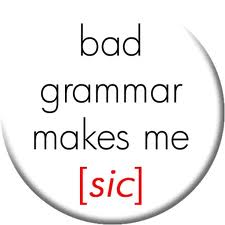Entries Tagged 'copywriting' ↓
February 22nd, 2012 — copywriter, copywriting, copywriting tips
 Writing copy might sound easy, but it’s a lot harder than you would think.
Writing copy might sound easy, but it’s a lot harder than you would think.
I’m sure, at some point, rather than using a copywriter you’ve sat down to write a piece of marketing copy for your business.
Distancing yourself from your business to write something that’s focused on your reader isn’t easy.
How to you make sure it flows?
How do you keep it clear and uncluttered?
7 Ways to keep you copywriting uncluttered
These 7 tips (for copywriters and non-copywriters) will help your writing flow and keep it crystal clear.
1. Focus
Don’t try to complicate your copy by addressing more than one idea. Keep your writing focused on one main aspect to keep it clean and uncluttered.
2. Clarity
It’s very tempting to start using great long words in an attempt to make yourself look highly educated.
Don’t.
The best copy uses simple, plain language that is accessible to everyone.
3. Plan
Always work out what you want to say before you start writing.
Your writing should follow a structure with a beginning, middle and end – just like you were taught at school.
By creating a plan, your writing will flow and follow a logical structure.
4. Layout
The layout can be as important as the content. Use it to clarify meaning by using headings and sub headings to signpost information. Bulleted lists and bold type can be used to highlight key points and benefits.
5. Be familiar
If you are writing about something complex, try to link it to something in everyday life that your reader will understand – using similes in this way can help make complex ideas simple.
6. Don’t be clever
It’s very tempting to add in a pun or two, but remember not everyone is going to find it funny. As a rule, it’s best to keep humour out of your copywriting.
7. Start with the most important
The most important part of your copy are the benefits, so make sure you get them in first in your heading and first paragraph. The rest of your copy should back them up with features and a strong call to action.
By following these simple ideas your copy will flow and get your message across clearly. Give it a try and then come back and tell us how you got on.
December 28th, 2011 — copywriter, copywriting, copywriting tips, marketing
 How to make your copy stand out
How to make your copy stand out
We are surrounded by marketing messages every day.
You can’t hide from them. Whether it’s the TV, magazines, radio, buses, taxis, billboards etc. everywhere you look, everywhere you go, someone is trying to sell you something.
So, if you’re one of those companies, how do you get your message to stand out from everyone else’s?
Well, it has a lot to do with your information presentation.
As a copywriter, my focus is always on the message, but I am well aware that colour, graphics and layout play a big part in the way an advert or message is received (even though, ultimately, it’s the words that will do the convincing and selling).
When it comes down to it, if you want your message to be seen, think about how it is presented.
Information presentation
There are 5 very simple things you can do to make sure your message isn’t ignored. I’m sure there are other things too (if you can think of any, leave a comment and share them with us), but these are my top 5.
1. Verb
Don’t worry, I’m not about to launch into a grammar lesson. But starting your heading with a verb instead of a noun will help it pack more of a punch.
A verb is a ‘doing word’ making it active, and if it’s talking about something you like doing, you’ll be more inclined to read on.
2. Short and sweet
Nope, I’m not about to dive in to the ‘long copy verses short copy’ argument. In this case, short and sweet refers to your sentence structure. Keeping them short will aid readability. They get across ideas succinctly. They keep your reader interested.
3. Another short and sweet
Your paragraphs should also be – you guessed it – short and sweet.
A page with lots of white space and short chunks of text will look far more attractive than a page with solid text.
Psychologically, it makes the reader think the information will be easy to read.
4. Loud
Once you’ve written your copy, do you ever read it out loud?
If you don’t, you should. Reading out loud will give you a whole new perspective on it. Plus, it will help you spot areas that sound clumsy or repetitive.
5. Check-list
After writing and refining your copy, check to make sure it is:
• Concise (think short sentences and paragraphs)
• Informative (and relevant)
• Attractive (lots of white space, readable font etc.)
If you can tick all 3, you’re well on your way to making your message stand out from the crowd.
Over to you
Can you think of any other ways to make sure your message stands out?
Leave a comment below and share them.
December 9th, 2011 — copywriting, copywriting tips, freelance copywriting, Suffolk copywriter, UK copywriter
In A Copywriter Gives Power to the Words we looked at the power words that can help convey your message clearly a nd concisely to your reader.
nd concisely to your reader.
But there is one very important word that I omitted to mention – “you”.
Why? Well believe it or not, freelance copywriters are actually human beings. We may well be shut away in our offices, sat in front of our computers being creative but we do also have lives and get to go out now and again.
Therefore it is important that copywriters use words to convey their humanness and the best one do that is you.
Writing using those three letters isn’t always easy though. If you have an academic background of any type (we all have) you would have been told time and time again not to address your reader directly.
Well, now you are writing sales material which is completely different and it is obligatory to use “you”, “yours” and “your”.
Everyone wants to be seen as an individual – and who is the person that people find more fascinating than anyone else? Themselves! Therefore always use “you” instead of “I”. So for example, instead of saying:
“Order now and I will send you a free gift”
Say
“Order now and you will receive a free gift.”
If you do have to write about yourself then “I” and “we” are better than your company name as it keeps it more personal and involving.
So remember – you are human, you exist, so talk to your reader conversationally – don’t talk at them from a distance.
Sally Ormond
December 5th, 2011 — copywriter, copywriting
 Neil Stoneham of Voxtree has kindly agreed to allow me to re-post his blog The Importance of Good Copy” on Freelance Copywriter’s Blog.
Neil Stoneham of Voxtree has kindly agreed to allow me to re-post his blog The Importance of Good Copy” on Freelance Copywriter’s Blog.
In it, he takes a good look at why good copy is so important for your business and why a professional copywriter is worth his or her weight in gold. Take it away Neil…
Here is a transcript of the forthcoming article I wrote for the Lancaster Chamber of Commerce magazine “Business Matters”:
Image, it seems, is everything in this day and age. Most of us go to some lengths to look good within a business environment, all with the express intention of dazzling our clients and creating a positive first impression. Same with the way our company is presented – we all want a good logo, flashy brochures and a smart-looking website.
So, what’s wrong with that? Nothing. Image is important, no doubt.
But it can all count for nothing if we neglect the necessity of good copy. As a copywriter myself, it pains me to see businesses splash out on a pristine, beautiful website, only for it to read like a third-rate student essay, replete with bad grammar, awful spelling and some unusual turns of phrase! It’s a waste and, at its worst, an insult to the intelligence of any prospective client.
Even less serious offenders can turn away potentially important sales by failing to write copy that is concise, persuasive and easy to read. After all, if you don’t sound professional, it may unintentionally suggest that your business is less than professional too.
A professional company cares about what it says as well as the way it looks. And it’s a proven fact that strong copy, written to draw people in and keep them hooked, is massively more effective than something bland or badly written.
Some of you may be worried now that your own copy is not very strong and that you ought to do something about it. Perhaps you’ve thought about it for a while but not got round to it. Well, here are a few pointers to help improve your copy so that it turns your core message into sales.
1. Make your text lively and persuasive
Many people feel the need to adopt a formal tone when describing their product or service. This can, however, fall flat and bore clients if you’re not careful. Today, most people accept a conversational tone as part of business patter and can be a boon if promoting something creative and quirky. If you are not sure, the best policy is to keep it neutral.
Remember, too, that you are selling. Clients are only really interested in how your product or service can be of benefit to them. Sounds obvious but it’s amazing how many businesses spend too much time ‘bigging themselves up’ at the expense of providing information that is actually useful.
 2. Accuracy is key
2. Accuracy is key
We rarely pay attention to good grammar, spelling and punctuation. In some modern contexts (social media or texting, for example) it may even seem unnecessary. Bad grammar, spelling and punctuation, on the other hand, stand out a mile. It looks sloppy and unprofessional. Even with the best will in the world, a few demons regularly stalk our copy – “their” instead of “they’re” and “your” instead of “you’re” are some of the popular ones. Get your copy checked by someone with a good knowledge of these things before you put it online or, worse still, send it to the printers.
3. Keep text concise
The phrase “Too much information” may have other connotations these days but is still relevant to sales material! When presenting the details of your product or service, tell us what we need to know and no more. Many technical aspects of your product, for instance, may seem important to you but can be tedious for all but the most tech-savvy geek to plough through. Also, get the point. Websites that spend the first two paragraphs detailing your company’s history could drive your potential client to the ‘back’ button and they’ll be away before you’ve told them a thing about what you do.
A word about Search Engine Optimisation (SEO) here. Don’t buy the myth that reams of keyword-heavy content will bag you a high ranking. The next generation of Google will filter this out and reward good quality content that is actually read and shared.
4. Avoid jargon and clichéd ‘marketing speak’
Unless you’re aiming your material at people solely within the same technical field, cut the jargon. Otherwise, it will alienate your clients and possibly lead to misunderstanding. Similarly, most smart people can see through ‘marketing speak’ these days, so treat people with respect and avoid phrases like this:
“When You succeed, we succeed with You. When you dazzle your CLIENTS, we dazzle ours.”
This was actually used by a company and guaranteed that a high percentage of potential clients were confused enough to go somewhere else!
There are, of course, many other issues that distinguish good from bad copy, so it’s worthwhile using a professional if you are serious about getting the words right. After all, it could make all the difference when generating that next big sale.
Over to you
Thanks Neil – so what do you think?
Can you come up with any other ideas why good copy is so important?
Perhaps you’ve seen some particularly good or bad examples?
Leave a comment below, we’d love to hear from you.
December 2nd, 2011 — copywriter, copywriting, copywriting tips
 This is going to be short and sweet, but what do you reckon?
This is going to be short and sweet, but what do you reckon?
Should your copy be humorous?
Is there a place for it?
Well, before you can answer that you really need to think about your brand.
You’ve worked long and hard to create a particular image, so before you decide to use a touch of humour in your next marketing campaign, ask yourself the following questions:
1. Is it really funny?
Perfecting a humorous campaign takes time. But you do have to remember that not everyone finds the same stuff funny.
Just because you’re humour makes you roll on the floor laughing, it doesn’t necessarily mean it will have that effect on everyone.
2. Oops
Not only do you run the risk of creating something that, for many, is not funny, but you could also end up causing offence.
Poking fun at certain people could land you in an awful lot of hot water.
3. Kill not cure
As I mentioned earlier, you have taken a lot of time and energy getting your brand’s image just right. If you’ve spent time and money creating something that’s renowned for its quality, seriousness and soberness and then put out an ‘amusing’ marketing campaign, you could turn off a lot of people very quickly.
The moral is…
At the end of the day, it’s a brave marketer that goes for the humour angle on a whim.
Make sure you look at your brand, your product and your audience before you start thinking comedy. After all, you want your customers to be laughing with you, not at you.
Sally Ormond – freelance copywriter
 Writing copy might sound easy, but it’s a lot harder than you would think.
Writing copy might sound easy, but it’s a lot harder than you would think.









